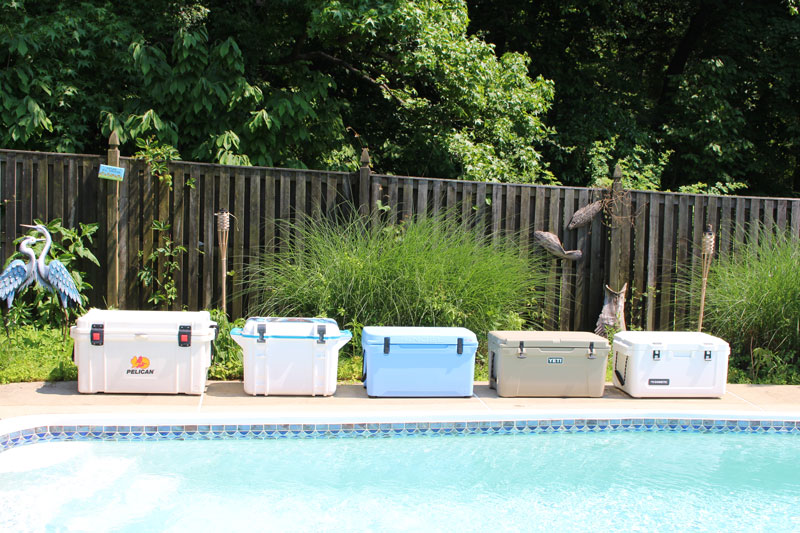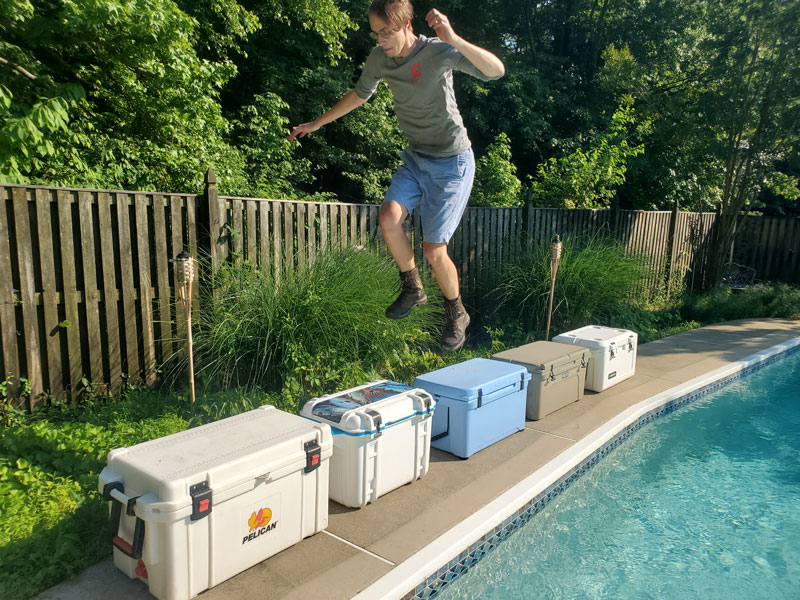Yeti, Dometic, Engel, Otter Box, and Pelican, prepare yourself to enter the Thermal Thunderdome and compete in a killer cooler cage match for super coolers. Like it or not, in our gladiatorial arena you’ll battle it out to determine which rectangular Rockatansky has the chilling characteristics to claim the temperate throne for ruggedness, ease of use, and the ability to hold ice through a hot summer day. Ladies and gentleman, boys and girls, chillin’ time’s here. But before we dig into the details, you can check out the competition on video:
Super Cooler Chill Test
The great claim to fame of any super-cooler is its ability to hold ice. All of the manufacturers claim that their coolers can hold ice for days on end, and that’s true enough if you fill them to the brim with rock-hard H2O, close the lid, and leave it that way for a week. But we anglers live in the real world. We mix cans of beverage in with the ice, and we open and close the cooler several times throughout the course of the day to retrieve those chilled refreshments. So, that’s how we performed our analysis of each cooler’s frost-factor.

First, we put a half-dozen cans of warm beverage into each cooler. Then we dropped in a realistic day’s worth of ice, two eight-pound bags. Striving to mirror real-world conditions, we ran up to the corner store, purchased the ice, and tossed it into the back of a pickup truck. Then we drove two minutes back to our industrial testing facility (“home”), and loaded up the contestants.
During the course of the next 24 hours, each cooler was opened long enough to remove a can of beverage and then latched shut again, six different times. Daytime temperatures were in the upper 80s, the sun was blazing, and the coolers were positioned to be in direct sunlight during daylight hours — conditions in which most regular el-cheapo coolers would convert ice to water in a matter of hours. At the end of the 24-hour period the ice bags in each cooler were pierced and the water allowed to drain, then weighed with a hand scale. The results:
Dometic Patrol 55 – Five pounds of ice remained.
Engel 65 High – Four pounds of ice remained.
Otter Box Venture 45 – Seven pounds of ice remained.
Pelican 65 Elite (recently replaced with 50 and 75 quart models) – Five pounds of ice remained.
Yeti Tundra 65 – Five pounds of ice remained
On the face of it, it would seem that the Otter was the real stand-out and the Engel lagged a hair behind the pack. But there’s more to this story. For starters, the one-pound deficit seen in the Engle is small enough that it could have been a result of which ice bags went into which coolers, and in our opinion is insignificant. When it comes to the Otter, there was simply less space to be chilled. Due to the different manufacturers making their coolers in different sizes it was impossible to test identically sized units in all cases. A smaller interior certainly means there’s going to be less melt-off, and the Otter has about 25-percent less space inside than the average for all these contestants. Even after accounting for that difference, however, the Otter Box still comes out slightly ahead.
No matter how you look at it all of these super-coolers did a super job of retaining ice, and were keeping those beverages frosty a full day later despite being opened and closed multiple times under a blazing summer sun. To the average angler, ice-retaining ability between these contestants is, in our opinion, a wash.
Torture Test
Next we wanted to compare ruggedness. What happens to a cooler on a boat? It gets sat on, stepped on, dropped, kicked, and bashed. Note that we didn’t include sliding across the deck and smashing into the inwales (or an unlucky crewmember’s shins), a common problem with those lame old regular coolers, because all of these combatants have rubbery non-skid feet which provide a firm grip.
True to our real-world methodology, we began our ruggedness test by donning a pair of hiking boots and walking across the lineup. Then, we ran. Next, we jumped — as high as possible, smashing our feet down to make the impact as strong as possible. Other than shaking some dirt out of the boot’s treads this had no visible effect. None of the cooler tops sagged, bent, or otherwise visibly flexed.

Wait, no damage?! Obviously, we needed to up our game. So, for a smash-test we discarded the monkey wrench we had planned to let fly, and instead opted for a 25-pound anchor. Ouch, that’ll hurt.
Except we found that it really didn’t.
In all cases the anchor more or less harmlessly bounced off the coolers when dropped from chest height. After each received two body-blows a close inspection showed that slight indents in the crescent shape of the anchors’ base could be seen on all of the contestants, with one exception: the Otter Box was blemish-free. Interestingly, however, a day later when we re-inspected the coolers we noticed that the marks on the other coolers had more or less disappeared. The plastic returned to form and while there was slight visible evidence on the Dometic and the Pelican, it took real effort to spot it.

Since the crushing blow of a large, heavy object didn’t cause any real damage to a single cooler, we decided to try blasting them with a small lead projectile at high velocity. No, we didn’t shoot them — tempting as the thought might have been, we do have neighbors to consider. Instead, we used another object common to fishing boats: a one-ounce jighead attached to the end of a line. This, we vigorously whipped in an arc to give each cooler five lashings. Yet the coolers again prevailed. It was impossible to identify any noticeable damage beyond microscopic scuffs on the five surfaces, even though much of the paint was chipped off the jighead and the lead was pock-marked and dented by the end of the test.
Which is the Best Cooler?
At this point we’d have to call all five of these competitors hands-down winners, and that means a judicious super-cooler buyer will have a difficult personal choice to make among them. However, as we ran through these tests several other traits, perks, and deficits became apparent. Before we dig into them, we want to stipulate that in all cases the tops of these super-coolers close shut tensioned against a gasket, their hinges are very thick (we’d say nearly indestructible) plastic over metal rods, and all are rotomolded with polyurethane foam insulation. All also have removable drain plugs, though only the Pelican and Otter have “keeper” attachments to prevent them from being lost or misplaced. The Dometic and Yeti come with coated wire basket-style food trays and the Otter comes with a plastic tray.
- Dometic Patrol 55 – The Dometic was the only cooler in this mix to have molded cupholders in the top. We like the rubberized pull-down latches, and although they aren’t as thick as some of the others, the openings in their ends make these the easiest to operate. We also felt that the rounded triangular design of the grips on the rope handles felt the most comfortable in-hand, an important feature since these coolers can get quite heavy when loaded. Speaking of heavy, the Dometic weighs in at 33 pounds. With a list cost of $279.99, it seems like a comparative bargain.
- Engel 65 High – A standout feature of the Engel is its 24-pound weight, which is significantly lighter than many of these others and makes it less of a hassle to carry around. Another stand-out is the slightly angled bottom inside, which directs water towards the drain without forcing you to lift and tilt the cooler. Its clip-down latches are unique among this crowd and do a great job of tensioning the top, and it warms our hearts to see that the hardware used with them is stainless-steel, not plastic. Fun fact: the stainless latch clips do double-duty as bottle openers. The Engel also has unique hard-plastic grips with finger ridges molded in on the rope handles. These caused some fumbling at first, but once you get your hands properly oriented, are comfortable. List price is $349.99.
- Otter Box Venture 45 – Otter Box offers a wider range of accessories for the Venture than most manufacturers, including clip-on roller wheels, a table, cupholders, and more. It also has a built-in bottle opener. Weight is 26.4 pounds and the rigid molded-in handles make this one a little tougher to carry than the others. The latches are both a plus and a minus. They rotate forward and lock into place, which tensions the cooler lid closed tighter than most. But their unusual lift/rotate design takes some getting used to and had us flummoxed for a few moments. We also noted that if you close the lid but fail to latch it down there’s a slight air gap at the front, so latching is a must if you want the cooler to do its ice-preserving job. List price is $299.
- Pelican 65 Elite – While our test-cooler had rigid swinging handles (which Pelican still uses on 95- and 150-quart models), the 50/70-quart models that have replaced it have molded in handles. A highlight is the metal hasp, the only one in this mix. It will make the cooler uber-secure when padlocked, should you ever see the need to provide those frosty beverages with hardened security. This is also the only cooler in the mix to utilize rigid latches instead of the rubberized type. They’re quite sturdy but they are plastic. Pelican earns copious goody-goody bonus points for molding a fish ruler into the top. List price is $329.95 for the 50 (26.4 pounds) and $389.95 for the 70 (33.3 pounds).
- Yeti Tundra 65 – Yeti is thought by many to be the king of all super-coolers, and they’re certainly the king of trademarking cooler part names (Coldlock Gasket™! Lipgrip Handles™! Vortex Drain System™!). Setting aside reputation and marketing acumen, we found the Yeti’s round rubbery grips very comfortable in-hand and the thick rubberized tensioning latches seemed likely to last longer than the others in the mix. We did notice that you have to be conscientious about pulling them all the way down and into the notch, or it’s possible to leave the cooler only partially latched by accident. Weighing in at 29 pounds, list price for the Yeti is $375.00.
(Note: all pricing is listed as of summer 2022).
Beyond Thunderdome
So, who traipses out of the Thermal Thunderdome in victory? One, and all. While each of these super-coolers does have its own low points, most are rather petty gripes. They’re all stunningly good at keeping your libations at low temperatures, and each and every one is built ruggedly enough to survive postapocalyptic life in the lawless Australian outback.